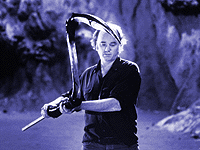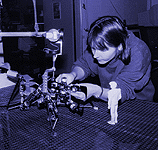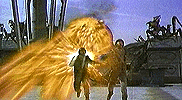


Makers of the Bugs
Tippett had been involved with TROOPERS producer Jon Davidson since 1976. "We were doing Roger Corman pictures together," Tippett told me. "We both loved sci-fi pictures, and we always wanted to work together on genre movies." Tippett, along with director Paul Verhoeven, producer Davidson and screenwriter Ed Neumeier collaborated on 1987's historic ROBOCOP. "TROOPERS was a great opportunity for the whole creative team to reunite. We all had a great time working together, and TROOPERS had such potential that I wanted to be involved from the beginning."
Involved with the project since 1990, Tippett witnessed the screenplay go through many changes. While the script was evolving, the world of visual effects evolved, too, as did the techniques planned to create the alien bugs. Tippett said, "The whole story was completely different in the early 90's... we started thinking about it back then, and mind you this was back in the pre-digital, pre-JURASSIC PARK days. We considered using traditional model photography, either stop motion or puppetry, and then of course everything changed in 1993 with JURASSIC PARK." It was directly after his involvement with JURASSIC PARK that Tippett Studio art director Craig Hayes, Verhoeven, Davidson, Neumeier and Tippett got together and started thinking about what the bugs would look like. "After JURASSIC, we generally decided that we could go digital with the bugs."
Craig Hayes was in charge of designing the look of the various alien species represented in TROOPERS. Tippett explained, "With the WWII themes presented by Paul, we wanted to continue that theme in the designs of the bugs, representing various generic elements of a war... the Warrior bug is a representation of mobile infantry, the Tanker bugs obviously are representational of WWII tanks, heavy artillery is represented in the Plasma bugs, and so on."
To allow seasoned stop-motion animators to be able to animate computer generated models for JURASSIC PARK, Hayes and Tippett developed the DID, a digital input device that allows an animator to have physical control over a CG model in real space. The
Tippett added, "Much of the way the bugs moved was dictated by Craig's designs... we did a lot of animatics, and assigned the bugs weights and the extent of its movements to come up with an animation design, to see how realistically these beings could move and run and attack. We also did months and months of research, including watching lots of documentary books and videos on various insects and bugs."
Lighting the bugs was an interesting challenge, as well, due to the varying conditions in which the bugs were to exist--both in harsh daylight and simulated moonlight situations. Lead Technical Director Larry Weiss supervised the lighting designs, among other duties. "In lighting the bugs in the daylight shots, we tried to recreate the lighting that an actual sky would produce, using a combination of lights acting as aerials, and a group of lights aiming up from the ground, in addition to the key (the sun), whose position was based on positioning data from the set." Using reference footage taken on location, including photographing a grey sphere and scale maquettes of the bugs, "we determined the color and intensity of each of those lights. It was a very accurate way of making the bugs appear as if they actually exist in the background plate."
For sequences where literally hundreds of Warrior bugs populate the screen, various time and processor saving tricks had to be performed. "Some shots were so complicated that they were taking up to 32 hours per frame to render. In order to simplify things, Darby Johnston developed a system that would streamline renders of background bugs that were not the focus of the shot," Weiss remarked. "We used a 'sprite' technique, where we would render out frames of a complete camera rotation around a single bug, and put those frames in a library." Weiss said that Johnston then wrote an algorithm that would determine which one of those frames to access, in relation to the bug's motion path and the camera's position. "This simplified things, and it helped in the render times, too, in that some of the final swarm shots only took 18 hours per frame to render," Weiss noted.
More Than Just Arachnids
The plasma blasts was a challenging task, especially since the data used to create the blasts was shared between Tippett and Sony Imageworks. "Tippett Studio designed the plasma blasts in Dynamation," Weiss said, "and then when Sony needed the blasts in their shots, we gave them all of our data so they could integrate the blasts into their shots. Walt Hyneman, who was co-CG supervisor at Sony for the show [along with senior CG supervisor Louis Cetorelli], was instrumental in translating our data. The plasma blasts that you see actually emerging from the rear ends of the Plasma bugs were completed at Tippett, while the ones that you see in the distance, or weaving in between spaceships were created by Sony using our Dymamation designs."
Tippett Studio has gone through some remarkable changes in the last couple of years, following the revolution from traditional optical effects to the digital realm. They've made the jump from creating effects for smaller pictures like THREE "...Tippett Studio is a different kind of effects house, due to the participation of the art department from conception throughout production."
Weiss commented that Tippett Studio is a different kind of effects house, due to the participation of the art department from conception throughout production. "It was their responsibility not only to design the models, but in painting and testing digital texture map designs--just like an art department would do in creature shop. They not only have to be great artists, but they also have to be somewhat technical, and be able to render out test frames and things like that. This allowed the lighting TDs and animators to concentrate on their lighting and animation duties."
Tippett, the creative supervisor and founder of his own company, noted, "No matter what technology is used, our focus has always been geared toward making a compelling picture and designing compelling choreography."
Academy Award winner Phil Tippett is no stranger to providing innovative solutions to filmmaking challenges. Some of the Academy Award winner's contributions to the
visual effects world are the stop-motion AT-ATs and go-motion Tauntauns from THE EMPIRE STRIKES BACK, the stop-motion ED-209 from ROBOCOP, and, more recently, the animation director of JURASSIC PARK. His company, Tippett Studio, tackled the enormous challenge of creating some 250 shots of full motion aliens for STARSHIP TROOPERS.

Oscar winning effects artist Phil Tippett on the set of TROOPERS.
CG model can be animated via a scale model fitted with motion sensors, which correlate to certain points on a CG model. After using it on JURASSIC and TREMORS 2, Tippett Studio dove head first into the dozens upon dozens of shots to animate for TROOPERS. "We've refined the DID since JURASSIC PARK," Tippett said, "in the overall cleanup of the design. Craig made sure that the DID would be much more responsive to the animator's movements... all of which was preparing for the massive amount of animation that was to be done on the DID for TROOPERS."

Animator Kirrie Edis makes an adjustment of the DID at Tippett Studios.
Tippett Studios' responsibilities didn't end with just the bugs and their animation. They also were tapped to create
various particle effects, including the Tanker Bug's lethal spray, and the Plasma Bug's destructive plasma blasts. Weiss remarked, "In designing the look of the tanker spray, we looked at a lot of lava footage for reference. It wasn't supposed to be lava, but it was meant to have that kind of consistency. We played around with Dynamation for a long time to come up with the final look."

The Tanker Bug's deadly spray of fire reaches two doomed soldiers at Whisky Compound.
WISHES and TREMORS 2 to the visual effects gorilla of STARSHIP TROOPERS. Tippett explained, "The essence of putting together effects shots hasn't changed much, although the technology used to put the elements together has changed dramatically. Whether you're stop-motion animating against a rear screen projection, or if it's against a bluescreen to be composited later, or if you're using CG animation, the aesthetic issues still have to be addressed, no matter what techniques or technology you're using."

Home - Who - Review - How - Pics: Bugs, Space, More

. . VFX HQ Produced by Todd Vaziri . . http://www.vfxhq.com . . e-mail: tvaziri@gmail.com . .
All text Copyright © 1998 Todd Vaziri, unless otherwise noted